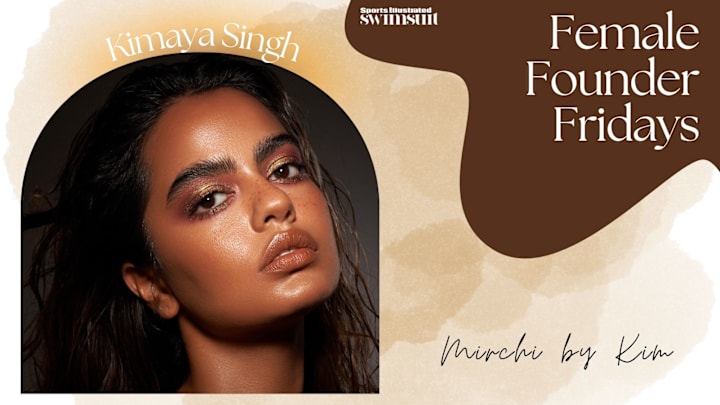Kimaya Singh Is Dressing the Main Character in All of Us

We’re spotlighting inspiring female founders who are making waves in their industries. Female Founder Fridays is all about celebrating their stories—how they built their brands, the challenges they’ve overcome and the lessons they’ve learned along the way.
Kimaya Singh has always believed that tradition deserves more than preservation—it deserves reinvention. With Mirchi by Kim, the model-turned-founder is reframing how South Asian craftsmanship shows up in the fashion world: intricate, unbothered by convention and entirely wearable.
Her debut collection—built on a made-to-order model and stitched by artisans in India—blends contemporary silhouettes with centuries-old embroidery techniques and a spicy, unmistakably South Asian flair.
“Mirchi was born from both reverence and rebellion,” she tells SI Swimsuit. “I’ve always been in awe of Indian craftsmanship—the detail, its soul, the quiet genius of generational knowledge. But I also grew up seeing how it was stolen, overlooked, misrepresented, or reduced to a cliché. I didn’t want to preserve culture—I wanted people to wear it, remix it, let it breathe in the present.”
This is a brand where nostalgia and defiance live in the same sequin—where centuries-old craftsmanship meets irreverent design and the spirit of a woman who’s always “too much” for the room, but never apologizes for it. Every piece is stitched with intention. And the 26-year-old visionary behind it is doing so much more than just designing, she’s also reclaiming narratives, creating jobs and dressing women in exactly what they deserve.
The quintessential Mirchi Girl
Every brand has a muse. For Mirchi, she’s a little wild, a little late, always overdressed—and completely unforgettable.
“Mirchi girls are chaos and clarity. They’re a contradiction in the best way. What they share isn’t a look—it’s a spirit. They show up fully, without softening themselves for the comfort of others,” she says. “I want Mirchi to feel like a mirror for that energy. Not aspirational. Just honest. Spicy, unfiltered, and rooted.”
And while the silhouettes may speak loudly, Singh is just as moved by the quiet moments of connection when the story behind a piece sparks something deeper.
“Watching someone from New York or Berlin proudly say, ‘This is handmade in India.’ Watching them tag their bags not just as accessories but as conversation starters,” she explains as what moves her most. “And it’s not performative—it’s curiosity, it’s respect. After years of watching our culture be appropriated, it’s powerful to see our stories be celebrated with context. A white girl rocking our Blue Lay’s bag and explaining to her friend what Magic Masala actually is. That’s a full-circle moment.”
That ethos spills into every part of the brand, from playful silhouettes to pieces that feel like walking declarations. Singh, who has posed for Danessa Myricks and Nike campaigns, gives a special shoutout to her partner Sophie Besl, who “embodies cross-cultural love” and reminds her that “allyship doesn’t have to be loud, it just has to be real.”
Wearing a story
Every Mirchi piece begins with a story; sometimes it’s a memory, sometimes a feeling. Singh brings references from her life in India and New York, childhood trips to the tailor and school notebook scribbles. She doesn’t approach her karigars (artisan or craftsman in Hindi) with a finalized sketch, but instead with an open dialogue.
“It starts with respect, not direction,” she says. “I show them references—textures from my childhood, old family photos, even scribbles from school notebooks—and we build the piece together.”
Mirchi artisans use techniques like aari, zardosi and cutdana embroidery, which date back centuries. But what excites Singh most is the interplay between these traditions and contemporary storytelling. “That’s where the magic happens—when tradition and experimentation meet in the hands of someone who truly understands the language of the needle.”
Each garment is both artwork and time capsule, made by a craftsman who is incredibly good at what they do. “I know their names, their kids, their stories. And I want the world to know them too,” she shares.
From the classic chili-beaded tank to the now-iconic Blue Lay’s Bag—“cheeky, chaotic, and kind of the perfect intro to Mirchi”—to the Devi and Shakti tassel pieces, named after her favorite goddess Durga, Singh’s work is built on intention. “Watching our artisans craft each beaded flower on the tassels… it never gets old. The detail, the intention, the power in those pieces—it feels like a prayer in motion.”
Slow fashion, loud impact
Mirchi’s made-to-order model reflects Singh’s commitment to sustainability, but not in the surface-level, marketing-driven way the term is often used. For her, slow fashion is both a political and cultural stance. Unlike fast fashion, which prioritizes speed over substance, Singh centers intention.
“Fast fashion doesn’t care who made your clothes—it cares how fast they ship,” she says. “But Mirchi is built around the opposite principle: the story is the product.”
Each piece is handcrafted by karigars in India, many of whom spend hours—sometimes days—embroidering a single item. Singh describes slow fashion not just as a business model but as “valuing the process as much as the piece.”
That visibility is especially vital to Singh when it comes to representation. “I want our girls—especially South Asian girls—to see themselves in this world not as a token, but as the main character,” she says. “To feel pride when someone compliments their skirt and they can say, ‘Thanks, it’s hand-embroidered in India.’ Not just pride in the product, but in the place.”
For Singh, the brand is ultimately about giving women permission to take up space, loudly and unapologetically. “South Asian women have spent generations being told what to do—how to dress, how to speak, what’s ‘respectable,’ what’s ‘too bold.’ But enough,” she says. “This is the time to do whatever the hell you want. You don’t owe obedience to outdated norms. You don’t need approval to take up space.”
Shop now at mirchibykim.com.
Female Founder Q&A
What’s the best advice you’ve ever received?
My grandfather—who continues to be one of my biggest inspirations—always said the most important thing in life is people. He was the kind of man who, even at a fancy dinner, would be thinking about what to carry back for the doormen at the hotel. He cared deeply, instinctively, and led with kindness.
He taught me that relationships—not money, not success, not status—are what actually endure. That people will forget what you did or made, but they’ll always remember how you made them feel. That ethos is the backbone of Mirchi. Whether it’s the way we speak to our customers, pay our artisans, or build community—it’s all rooted in care. And that comes from him.
What do you wish you knew before starting your brand?
You can’t avoid the numbers. And believe me—I tried. I knew it even then, and I still avoided it. But eventually, the spreadsheets catch up with you. You can have all the creativity and vision in the world, but if you don’t have a handle on your finances, you’ll burn out—or worse, you’ll undersell your worth.
Now, I’m learning to treat financial clarity as a form of self-respect. It’s not about becoming “corporate”—it’s about creating stability so the creativity can actually thrive.
What was your ‘I made it’ moment?
Honestly? Every single day feels like a small ‘I made it’ moment. When we get messages from girls around the world telling us Mirchi makes them feel seen or helps them reconnect with their culture, it still feels surreal.
But if I had to choose one tangible moment, it’s when people stopped me or Sophie on the street to ask if we are wearing Mirchi. The fact that in just 10 months, something we made is recognizable in the wild—that still blows my mind. We’ve barely scratched the surface, but seeing Mirchi turn into a living, breathing community...that’s the win. That’s the dream.
What has been the most unexpected challenge of running the business?
The speed. We manifested growth, we hoped for it, but when it actually started happening so fast, it caught us off guard. Suddenly, there’s this huge global community, real momentum, and we’re still a tiny team figuring things out on the go.
Now the challenge is: how do we sustain this without losing what makes it special? How do we grow without dilution? How do we protect the slowness of our craft while meeting the urgency of demand? It’s a constant dance. We’re learning in real time—with no playbook, just instinct. And weirdly, that’s what keeps it exciting. It’s chaos, but it’s our kind.
What’s your favorite memory from starting the brand?
Our first NYC launch party. Sophie and I planned it—very on-brand—a week before. Total chaos. The night before was a nightmare; the website wasn’t ready, and there were so many loose ends.
But when the day came, over 500 Mirchi girls showed up. All dressed up. All there for us. The night was electric. There was love, laughter, sparkle and this unspoken sense of shared identity. A room full of people who believed in the vision, who felt Mirchi. I remember stepping back in the middle of the crowd and thinking, This is what it’s about. Not the product, not the press—but the feeling. That moment will stay with me forever.
Next. Inside the World of Maison des Nus, Where Basics Don’t Have to Be Boring. Inside the World of Maison des Nus, Where Basics Don’t Have to Be Boring. dark
